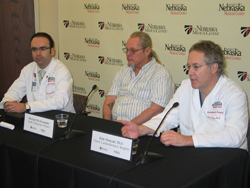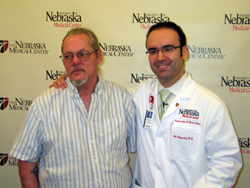 |
(From left) Ali Khoynezhad, M.D., Mike McAlexander and Kim Duncan, M.D., discuss the rare heart surgery that Dr. Khoynezhad performed on McAlexander in August. The surgery, known as the “frozen elephant trunk,” was believed to be the first of its kind performed in the United States. |
Ali Khoynezhad, M.D., Ph.D. performed the rare surgery. As a cardiothoracic and endovascular surgeon at The Nebraska Medical Center and assistant professor of cardiovascular and thoracic surgery at UNMC, he’s seen a variety of life threatening conditions that require urgent action. The situation he faced on Aug. 15 was different than most.
“Our patient was critically ill. Nearly every inch of his aorta had dissected or split,” Dr. Khoynezhad said. “Without surgery, he would have almost certainly died.”
Hours earlier, Michael McAlexander was at his Omaha home putting together a book shelf. The 54-year-old had run into health trouble before. The previous year he had suffered a partial dissection of his descending aorta. Brought on by extremely high blood pressure, McAlexander was put on medication to control his hypertension and was being monitored. Aches and pains were nothing new, until the inside lining along the rest of his aorta — close to his heart — ripped apart.
“I felt massive pain like nothing I had ever felt before. I didn’t know what it was, but I figured it would go away,” he said. “Three hours later my wife took me to the emergency room at the VA hospital. Within two hours I was transferred to The Nebraska Medical Center and prepped for surgery.”
Dr. Khoynezhad went into the operating room prepared to take action. He embarked on a one-of-a-kind surgery, the “frozen elephant trunk,” knowing that it provided the best option to save his patient’s life. He first replaced the ascending aorta, the aortic arch and two branch arteries to the brain, the innominate and left carotid. Badly diseased human tissue was completely replaced with a synthetic manmade material — a Dacron® vascular graft — that from this point forward would function as the aorta.
While most of the graft was stitched into place, an end portion was left extending inside the true lumen, or pathway, of the aorta. This seemingly minor detail is actually a critical part of the procedure.
“This piece of fabric is the ‘elephant trunk.’ It guides the surgical team to the true lumen, the correct channel of the aorta where blood should be flowing,” Dr. Khoynezhad said. “Remember, the dissection had split the aorta into two. If the surgeon was to misidentify the lumen and proceed with the rest of the operation in the false lumen where the vessel wall is particularly weak, it could be catastrophic.”
With the elephant trunk as his guide, Dr. Khoynezhad next repaired the damaged portion of the descending aorta. Over a guidewire, he inserted a permanent stent graft, the GORE TAG® thoracic endoprosthesis, through the newly rebuilt ascending aorta. He directed it into place in the descending aorta lying along the spinal column in the chest. Now that the stent was confining blood flow to the newly rebuilt vessel, blood could no longer reach the aneurysm allowing the bulge to shrink over time.
 |
Mike McAlexander, and his surgeon, Ali Khoynezhad, M.D., celebrate the success of the surgery at the end of the news conference. |
This process involves a heart-lung machine and cardiopulmonary bypass to first chill the blood and later, after completing the initial portion of surgery, to restart blood flow and rewarming. Once the patient’s body temperature reaches 18 degrees Celsius (64 degrees Fahrenheit), the bypass machine is stopped and the surgeon has a short window, 30 to 45 minutes, to complete the surgery that involves the arteries supplying blood to the brain.
At the same time, with the use of retrograde cerebral perfusion, a low level of cooled, oxygenated blood continues to flow to the tissue of the brain. Without this crucial component, it is not possible to replace the aortic arch. The patient would not have adequate blood flow to the brain resulting in the possibility of severe brain injury.
“This operation required an incredible amount of teamwork and precision by a very talented surgical team,” Dr. Khoynezhad said. “Every person in the operating room was focused from start to finish. The surgeons, the nurses, the anesthesiologist, the perfusionist — we all had a critically important job to do. Nine hours later, we wrapped up knowing that we had done all we could do to give our patient a second chance.”
Less than 12 hours after surgery, Michael McAlexander was breathing on his own and without the use of a ventilator. Several days later he was discharged. Numerous check-ups and scans in the months following show his recovery is going well.
“I’m thankful. My wife Cheryl, Dr. Khoynezhad and God have seen me through this,” McAlexander said. “It is taking a while for my strength and stamina to return. I still have aches and pains but I am feeling better.”
Variations of the frozen elephant trunk procedure for aortic dissection have been performed previously in the United States, however, instead of repairing all portions of the aorta in one session the earlier operations were split into at least two separate procedures happening days or even weeks apart.
Kim Duncan, M.D., chief of cardiothoracic surgery and professor of cardiothoracic surgery at UNMC, stresses the combined nature of the operation speaks highly of the skill and collaboration of Dr. Khoynezhad and his team in this innovative approach to patient care.
“The hybrid procedure using open surgical technique along with the intraoperative use of endovascular stenting techniques made this procedure shorter, more efficient and ultimately safer for the patient,” Dr. Duncan said. “People in this region need to know they don’t have to travel far to find the best, most advanced vascular and cardiac care. We’re providing it right here in Omaha.”
In April of 2006, Dr. Khoynezhad performed a separate groundbreaking surgery — Omaha’s first minimally invasive repair of a life threatening thoracic aortic aneurysm. This procedure also relied on an endovascular approach. The same type of thoracic aortic stent used in the frozen elephant trunk procedure was delivered through the femoral artery in the groin and expanded inside the abnormally distended aorta in the chest.
To date, the only published reports on complete frozen elephant trunk surgeries for aortic dissection come from surgeons in Germany and Japan.
Animation showing art-based snapshots of the frozen elephant trunk procedure can be viewed at www.nebraskamed.com.